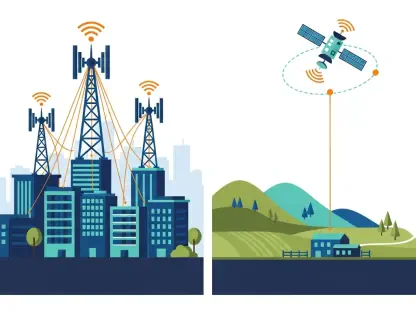How can businesses achieve the security of a private network without the overwhelming costs and complexity of managing one? In a world where industries like healthcare and logistics depend on lightning-fast, secure data transfers, T-Mobile has unveiled a revolutionary solution. Known as Edge Control, this hybrid 5G network offering blends the best of public and private connectivity, promising to transform how companies operate in a data-driven landscape. This innovation taps into T-Mobile’s cutting-edge 5G-Advanced technology, setting a new benchmark for flexibility and efficiency.
The significance of this development cannot be overstated. With the explosion of IoT devices and the urgent need for real-time data processing, businesses face mounting pressure to secure their networks while keeping expenses in check. Edge Control addresses this critical challenge, offering a scalable solution that caters to diverse industries. By leveraging T-Mobile’s robust spectrum holdings and advanced infrastructure, this hybrid model is poised to reshape network management, delivering private network-like performance over a public framework.
A Turning Point for Network Flexibility
T-Mobile’s latest breakthrough marks a pivotal shift in how connectivity is approached. Edge Control, built on the foundation of a 5G standalone (5G SA) network, allows companies to enjoy the benefits of a private system without the traditional barriers of cost and setup intricacy. This hybrid approach ensures that businesses can prioritize security for sensitive data while utilizing public channels for less critical operations, all managed seamlessly.
Industries that thrive on low-latency and high-security requirements stand to gain immensely. For instance, a manufacturing plant could safeguard proprietary production data on a private slice of the network while routing general communications through public channels. This dual functionality not only streamlines operations but also slashes the financial burden of maintaining entirely isolated systems, making advanced connectivity accessible to a broader range of enterprises.
The Rising Need for Hybrid 5G Solutions
As digital transformation accelerates across sectors, the demand for robust network solutions has reached unprecedented levels. Healthcare providers transmitting patient records, logistics firms tracking shipments in real time, and retailers managing vast IoT ecosystems all grapple with the same dilemmhow to balance security with affordability. Hybrid 5G networks, like the one T-Mobile has introduced, emerge as a vital answer to this pressing issue.
The stakes are high in an era where data breaches can cripple operations overnight. Latency issues, too, pose significant risks, especially for applications requiring instantaneous responses, such as remote surgeries or autonomous vehicle systems. By integrating public and private network strengths, Edge Control offers a lifeline, enabling companies to stay competitive without sacrificing performance or safety in their digital endeavors.
Inside Edge Control: Features That Innovate
At the heart of T-Mobile’s hybrid solution lies a suite of transformative capabilities designed for modern business needs. Edge Control operates on the 5G SA network, delivering speeds and security akin to private setups while utilizing the cost-effective public infrastructure. This balance eliminates the need for expensive, standalone private networks, providing an economical alternative without compromising quality.
A standout component is the T-Platform, a unified management portal that simplifies network oversight. Through this intuitive interface, businesses can segregate critical data—such as clinical records in a hospital—onto private channels while directing non-sensitive traffic, like guest Wi-Fi, to public pathways. This level of control ensures both efficiency and protection, tailored to specific operational demands.
Additionally, Edge Control caters to sector-specific challenges with remarkable precision. Transportation companies, for example, can manage real-time fleet data securely, while entertainment venues can handle high-volume visitor traffic without overloading critical systems. Backed by T-Mobile’s extensive spectrum resources, this solution positions the company as a trailblazer in customized 5G applications for data-intensive fields.
Industry Voices Highlight Competitive Strength
Feedback from experts underscores the potential impact of T-Mobile’s hybrid offering. Roy Chua of AvidThink lauds the alignment with successful models like China’s public network-integrated private networks (PNI-NPN), where carriers oversee private setups for enterprises. “This approach is transformative for sectors like retail and energy, where local data processing and stringent security are essential,” Chua explains, highlighting the practical value for diverse industries.
T-Mobile’s own leadership echoes this optimism. Mo Katibeh, chief marketing officer for T-Mobile for Business, emphasizes the economic edge of Edge Control, stating, “It delivers private network performance without the heavy overhead, ensuring a superior total cost of ownership.” When compared to competitors like AT&T and Verizon, who are still scaling their 5G SA deployments, T-Mobile’s early adoption of 5G-Advanced features—such as L4S for optimized video streaming—solidifies its frontrunner status in the market.
This competitive advantage is not just theoretical. With other carriers playing catch-up on advanced network rollouts, T-Mobile’s ability to offer cutting-edge solutions today gives businesses a head start. This lead is particularly crucial for industries reliant on immediate, secure connectivity, positioning T-Mobile as a preferred partner in the 5G landscape.
Real-World Impact for Businesses
For companies looking to adopt Edge Control, the path to implementation is both practical and strategic. A starting point involves assessing data priorities—determining which operations, such as financial transactions in retail, demand private network protection versus those that can safely use public channels. This initial step ensures resources are allocated effectively, maximizing security where it matters most.
The T-Platform plays a pivotal role in execution, offering real-time monitoring and automated traffic routing. Businesses can reduce manual intervention by leveraging this tool, allowing for dynamic adjustments as network demands shift. For instance, a logistics firm could instantly prioritize shipment tracking data during peak seasons, ensuring seamless operations without constant oversight.
Scalability remains a key benefit, enabling gradual integration of hybrid setups. Companies can begin with mission-critical applications and expand as needs grow, relying on T-Mobile’s adaptable infrastructure to avoid costly overhauls. This phased approach minimizes disruption while aligning network capabilities with long-term business goals, fostering both innovation and stability in a 5G-driven environment.
Reflecting on a Network Evolution
Looking back, T-Mobile’s introduction of Edge Control and the T-Platform marked a defining moment in the journey of 5G technology, seamlessly merging public and private network benefits to address varied industry challenges. This hybrid innovation tackled the dual demands of cost-efficiency and high performance, setting a precedent for how connectivity could evolve to meet modern demands.
The broader implication was a shift toward flexible network architectures that empowered businesses to thrive in data-intensive settings. For enterprises navigating the complexities of IoT and real-time processing, the next steps involved exploring how to integrate such solutions into their operations. Evaluating specific data needs and partnering with forward-thinking providers became essential actions to harness the full potential of hybrid 5G systems.
Beyond immediate adoption, the focus shifted to anticipating future advancements in network technology. Staying ahead of trends and investing in scalable solutions offered a way to maintain a competitive edge. T-Mobile’s pioneering step laid the groundwork, but the ongoing challenge for industries was to adapt and innovate, ensuring that connectivity remained a driver of progress in an ever-changing digital landscape.









